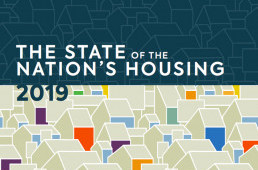
July 19, 2019 | by Michael Wilt
Categories: Affordable Housing, Construction, Homelessness, Homeownership, Rental Housing
Each year, the Joint Center for Housing Studies of Harvard University (JCHS) publishes a State of the Nation's Housing report documenting the pace of housing production, cost of housing, and changing market conditions and household indices.
Released last month, the State of the Nation's Housing 2019 report's main finding is that housing production is still lagging, which means home prices and rents continue to climb due to constrained housing supply. With household growth expected to remain steady over the next decade, the main test of the housing market will be if it can produce a “broader and more affordable range of housing options for tomorrow's households.”
There are five other primary findings in the report summarized below.
We invite you to check out the interactive maps (located here) to see what's going on in your area in addition to reading the full report. We also invite you to follow the Joint Center for Housing Studies of Harvard University on twitter @Harvard_JCHS to learn about their report and stay up to date on housing trends and issues.
On the House blog posts are meant to provide general information on various housing-related issues, research and programs. We are not liable for any errors or inaccuracies in the information provided by blog sources. Furthermore, this blog is not legal advice and should not be used as a substitute for legal advice from a licensed professional attorney.
TSAHC reviews all blog comments before they are posted to ensure a positive experience for our online community. Off-topic comments; hostile, derogatory or deliberately insulting comments; and comments specifically promoting goods and services will not be posted.
Approved comments will be published in their entirety. Personal information will not be removed unless it pertains to someone other than the person submitting the comment. For more information, please see our Comment Posting Guidelines.
To remove a previously submitted and published comment, please contact Anna Orendain at [email protected].
If you have a question regarding any of TSAHC's programs, please contact us.

Thanks for the update